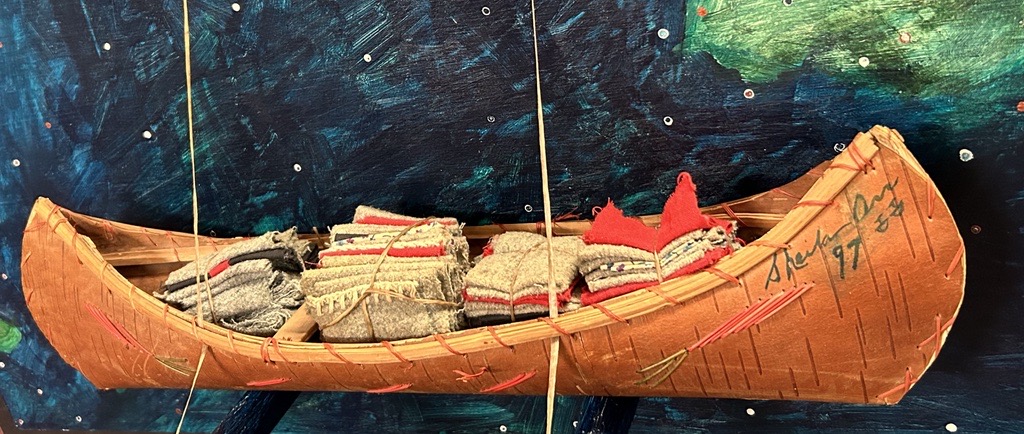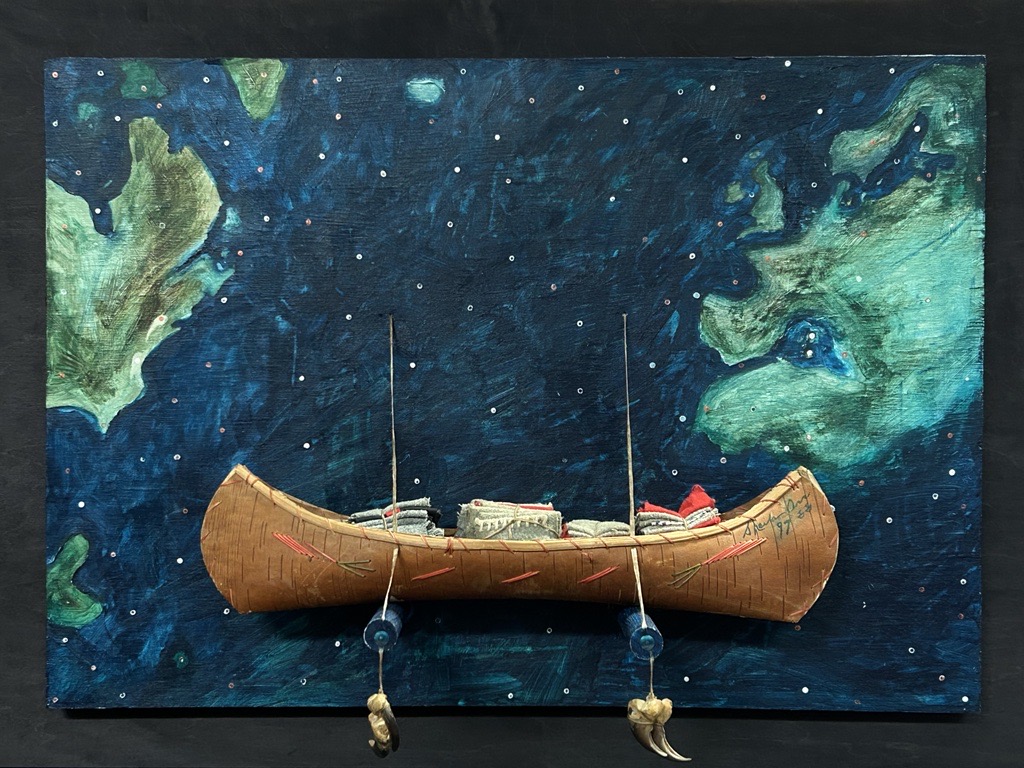Sheila Orr's artwork Returning Tainted Gifts, 1999, was recently donated to SK Arts' Permanent Collection by the estate of Orr’s friend and former co-worker, Carolyn Cardinal. The mixed-media work captures Orr's signature dreamscape vision style and consists of a miniature bark canoe – anchored by bear claws – that is filled with stacks of bound wool blankets. The canoe is floating in front of a painted aerial view of Canada's east coast. The artwork was conserved to remove dust, dirt and smoke residue upon donation before being placed in a protective custom-built Plexiglas box and frame, a process that took almost two years.
Julia Krueger, Registrar at SK Arts, says the piece is an excellent example of Orr's aesthetic as she is known for incorporating various materials within a single work.
A Painful Past

Close up of canoe in Retuning Tainted Gifts, Sheila Orr, 1999.
But this arresting artwork tells the story of a haunting and heartbreaking past. It portrays a painful history of blankets and other 'gifts' infected with smallpox that were given to Indigenous people. According to the Canadian Encyclopedia, multiple waves of the smallpox epidemic swept through the Canadian prairies, “where it is estimated that more than half of First Nations people living along the Saskatchewan River (territory of the Nehiyawak, Saulteaux, Assiniboine and Niitsitapi) died of smallpox or epidemic-related starvation” (Spaulding, William B. and Maia Foster-Sanchez. "Smallpox in Canada". The Canadian Encyclopedia, 12 February 2020, Historica Canada. www.thecanadianencyclopedia.ca/en/article/smallpox. Accessed December 23, 2024.).
The disease was particularly deadly to Indigenous people who had no immunity owing to a lack of previous exposure and later inoculation - a theme common for numerous communicable diseases, such as measles.
Orr's Returning Tainted Gifts embodies the symbolic return of those gifts. The stacked blankets inside the canoe are made from a police officer's garments and RCMP blankets. Orr explained the material history of the blankets symbolized the authority of a government which inspired trust. The “gifting” of smallpox-infected blankets represents that misplaced trust and the devastating effects for Indigenous communities. Meanwhile, the bear claws are a sign of protection for the unknown traveller who is returning the tainted gifts in the canoe. The aerial view of Canada's east coast is meant to displace time.
Returning Tainted Gifts also features a covering of small spots, which are prominent in Orr's work, representing smallpox disease, and stars or snowflakes that symbolize hope for the traveller.
"They're like a symbol of hope. For this piece, they [the dots] represent the pain of what was used to try and destroy my people. But they are also to be seen as hope—stars or snowflakes," said Orr. "I also just think they are fun!"
When talking with SK Arts' communication strategist Shandean Reid, who happens to be a recent immigrant from Jamaica, where the Indigenous population native to the island (the Arawaks) did not survive Columbus' arrival, Orr shared that she created the piece for an exhibition at Neutral Ground Artist Run Centre in Regina, Saskatchewan, that was inspired by the highly political and controversial 1992 exhibition INDIGENA: Perspectives of Indigenous Peoples on the Five Hundred Years in Ottawa, co-curated by Indigenous curators and scholars Lee-Ann Martin and Gerald McMaster during Christopher Columbus' Quincentenary, the 500th year anniversary of his arrival in America. Martin and McMaster felt that un-filtered Indigenous voices were missing from art spaces and felt that INDIGENA appropriately brought those voices forward in a manner they had not been previously.
About the Artist
Orr is an important Indigenous artist who has contributed considerably to the formation of Contemporary Canadian Indigenous Art. She studied Indian Fine Arts, Visual Arts and Arts Education at the Saskatchewan Indian Federated College (now the First Nations University of Canada).
For nearly two decades, she lectured and taught studio classes with subjects and themes focusing primarily on traditional and contemporary First Nations arts, culture and aesthetics, beadwork, porcupine quillwork, hide work and two-dimensional design. She currently lives in northern Saskatchewan.
The presence of Orr's work in SK Arts' Permanent Collection, and its availability to the public more than 30 years after its creation, represents the agency's acknowledgement of the importance of including Indigenous art, history and its people in the Collection. SK Arts' new CEO, Lisa Bird-Wilson's commitment to proactively identifying and addressing barriers faced by underserved communities, including Indigenous, newcomers, 2SLGBTQ+, Deaf artists and artists with disabilities, as an Indigenous person herself, is a display of serendipitous connection.
“I am incredibly honoured to be a part of the move towards breaking down barriers and advancing more inclusive representations of artists in SK Arts’ Permanent Collection,” said Bird-Wilson.

Retuning Tainted Gifts, Sheila Orr, 1999. SK Arts Permanent Collection. Donated by Carolyn Cardinal.
